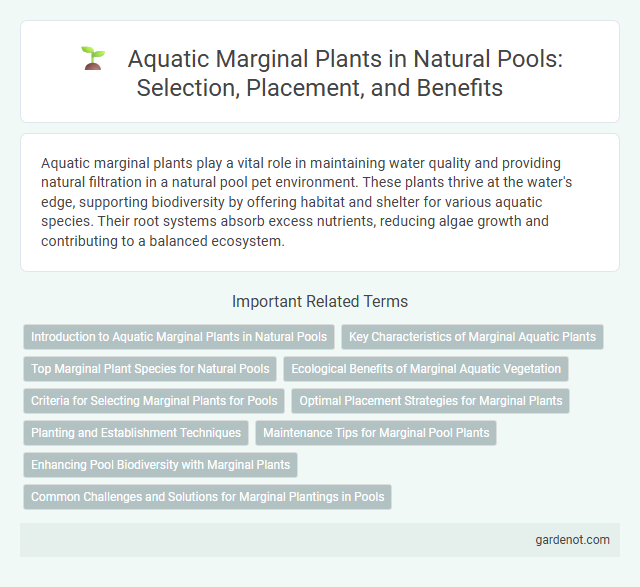Aquatic marginal plants play a vital role in maintaining water quality and providing natural filtration in a natural pool pet environment. These plants thrive at the water's edge, supporting biodiversity by offering habitat and shelter for various aquatic species. Their root systems absorb excess nutrients, reducing algae growth and contributing to a balanced ecosystem.
Introduction to Aquatic Marginal Plants in Natural Pools
Aquatic marginal plants in natural pools serve essential ecological functions by stabilizing the shoreline, enhancing water clarity, and providing habitat for beneficial microorganisms and wildlife. Species such as cattails, water irises, and sedges thrive along the pool's edges, filtering pollutants and preventing erosion through their extensive root systems. These plants contribute to the natural pool's balanced ecosystem by promoting nutrient uptake and improving overall water quality without the need for chemical treatments.
Key Characteristics of Marginal Aquatic Plants
Marginal aquatic plants thrive at the interface between water and land, featuring robust root systems anchored in saturated soils or shallow water, which stabilize pool edges and reduce erosion. These plants exhibit high tolerance to fluctuating water levels and contribute to natural filtration by absorbing excess nutrients, enhancing water quality in natural pools. Their dense foliage provides habitat for aquatic wildlife and supports biodiversity while improving the aesthetic appeal of natural swimming environments.
Top Marginal Plant Species for Natural Pools
Top marginal plant species for natural pools include cattails (Typha latifolia), water irises (Iris versicolor), and pickerelweed (Pontederia cordata), which enhance water filtration and provide essential habitat for aquatic wildlife. These aquatic marginal plants thrive in shallow water zones, improving water quality by absorbing excess nutrients and stabilizing the pool's edge against erosion. Incorporating a diverse range of these species promotes a balanced ecosystem within natural pools, supporting biodiversity and maintaining clear, healthy water.
Ecological Benefits of Marginal Aquatic Vegetation
Aquatic marginal plants in natural pools play a crucial role in enhancing water quality by filtering pollutants, trapping sediments, and cycling nutrients effectively. These plants provide vital habitats for diverse aquatic organisms, promoting biodiversity and stabilizing the ecosystem. Their root systems reduce erosion along pool edges, contributing to the overall ecological balance and sustainability of the aquatic environment.
Criteria for Selecting Marginal Plants for Pools
Selecting aquatic marginal plants for natural pools requires evaluating their adaptability to water levels, growth rate, and oxygenation capacity. Plants such as cattails, irises, and pickerelweed thrive in shallow zones with fluctuating water depths, contributing to water purification and habitat diversity. Choosing species with robust root systems and tolerance to seasonal changes ensures long-term ecological balance and effective nutrient absorption.
Optimal Placement Strategies for Marginal Plants
Optimal placement of aquatic marginal plants in a natural pool involves positioning them along the shallow perimeters where sunlight penetration is highest, typically within depths of 15-30 centimeters. Strategic clustering of species such as water irises, pickerelweed, and cattails enhances nutrient uptake and stabilizes substrate, reducing algae growth and sediment disturbance. Ensuring diverse plant densities in these zones promotes effective biofiltration and maintains balanced aquatic ecosystems.
Planting and Establishment Techniques
Aquatic marginal plants play a crucial role in natural pool ecosystems by enhancing water filtration and providing habitat for beneficial microorganisms. Effective planting and establishment techniques include selecting native species suited to the pool's water depth and sediment type, ensuring proper spacing to promote healthy growth and prevent overcrowding. Incorporating biodegradable planting baskets or mats helps stabilize root systems during establishment, reducing erosion and facilitating nutrient uptake for optimal plant development.
Maintenance Tips for Marginal Pool Plants
Aquatic marginal plants in natural pools require regular pruning to prevent overgrowth and maintain water circulation. Removing dead or decaying leaves reduces nutrient buildup that can cause algae blooms. Ensuring proper spacing and periodic repositioning helps sustain healthy root systems and supports diverse aquatic ecosystems.
Enhancing Pool Biodiversity with Marginal Plants
Aquatic marginal plants, such as cattails, water irises, and pickerelweed, play a crucial role in enhancing natural pool biodiversity by providing habitat and food for a variety of aquatic and terrestrial species. These plants improve water quality through nutrient uptake and oxygenation, supporting a balanced ecosystem within the pool. Incorporating diverse marginal vegetation increases ecological stability and encourages the proliferation of beneficial insects, amphibians, and microorganisms essential for a healthy natural swimming environment.
Common Challenges and Solutions for Marginal Plantings in Pools
Aquatic marginal plants in natural pools often face challenges such as water imbalance, pest infestations, and nutrient deficiencies, which can hinder their growth and ecological function. To address water imbalance, maintaining proper water levels and circulation is essential to prevent root rot and stagnation. Implementing integrated pest management and periodically supplementing with aquatic fertilizers can promote healthy marginal planting and sustain biodiversity in the pool ecosystem.
Aquatic marginal plant Infographic

 gardenot.com
gardenot.com